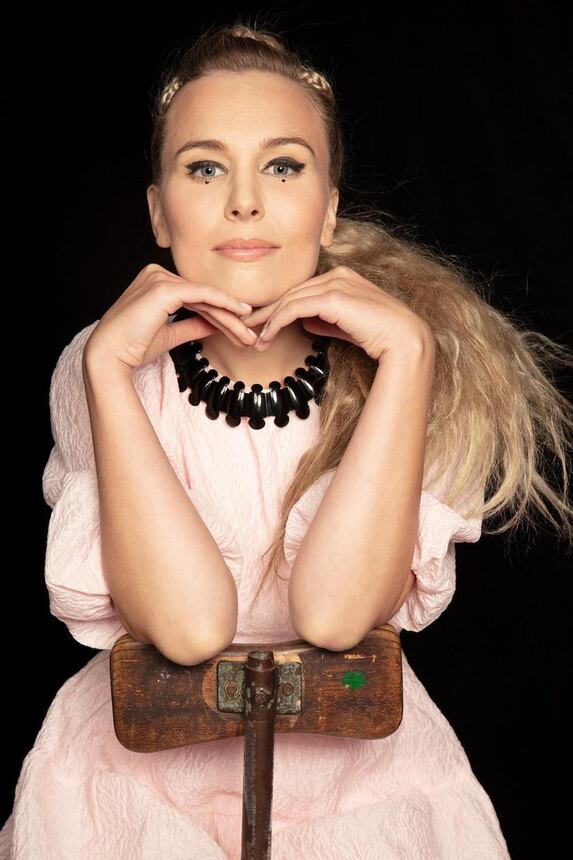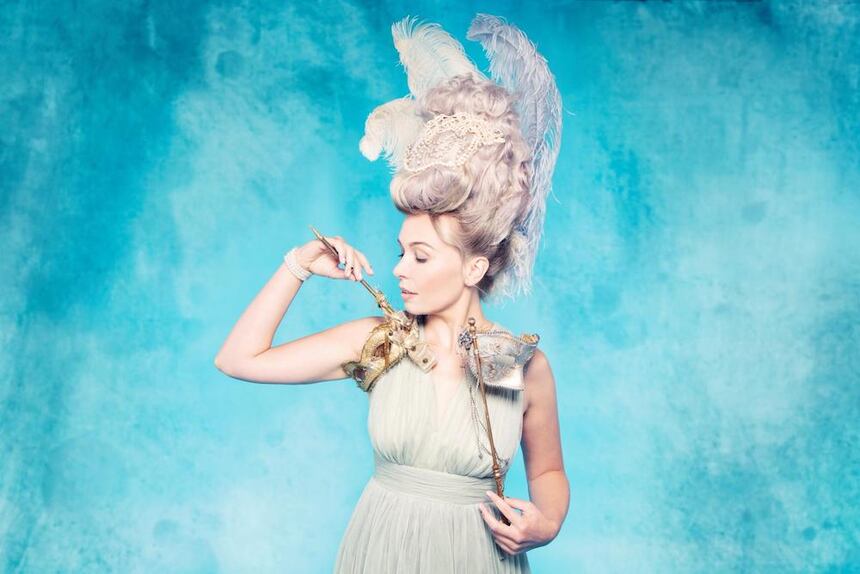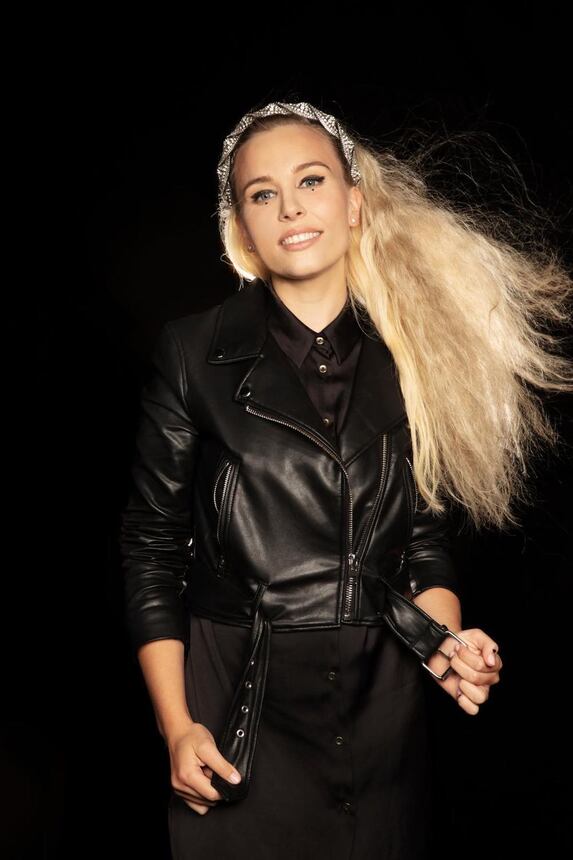Elsa Dreisig is bursting with joy in front of the zoom camera from her Paris flat. The time has finally come: her new album Mozart x 3 on Warner Classics is released. It follows her successful debut Miroir(s) (2018) - one of our previous Qobuzissimes - and Morning (2020). Mozart x 3 is not only her third solo album but also her third album that starts with the letter ‘M’... not to mention it is also called ‘times three’. Destiny? “It’s really strange that “Mozart x 3″ is my third album, maybe there’s no coincidence, maybe it all has a meaning I don’t know yet, this letter ‘M’.”
In any case, the pieces selected for the album are anything but a coincidence. Elsa Dreisig's programmes are polished down to the last detail, neatly selected and provided with an accompanying meaning. Already in Miroir(s) we were able to experience a reflection of very different repertoires as well as composers, a conscious encounter of different musical styles, dramatic moments and epochs. In Mozart x 3 there is another juxtaposition: Dreisig presents us with the heroines of the three Da Ponte-Mozart} operas Le nozze di Figaro, Così fan tutte as well as Don Giovanni, and contrasts them with the protagonists of three 'opere serie' ("serious operas") by Mozart, Idomeneo (Elettra), Lucio Silla (Cecilio) and La clemenza di Tito (Vitellia). She tells us herself how she arrived at this selection: "This album was more of an exchange. I spoke with Alain Lanceront, the director of Warner Classics & Erato. He told me about his somewhat crazy idea of recording all the Da Ponte operas with a single singer. And he already knew that I like challenges, that I like crazy things."

© Simon Fowler
It does sound a bit crazy, if not daring. But Elsa Dreisig is not afraid of anything and went into the studio with the Kammerorchester Basel and conductor Louis Langrée in June 2021 to record this huge project. One thing quickly becomes clear: the interpretation of the woman, whether as heroine or schemer, lover or heartbreaker, is the centre of the programme. She herself describes: "Who are these women I sing? What are their personalities? And how can I deal with the music that already exists, with the text that already exists, how can I find the key to this person? And in this album, with Mozart, more than with any other, there are similar structures in the great leading roles, whether it's Fiordiligi or the Contessa, or Donna Anna and Donna Elvira. They have this big entrance on stage at a certain moment with this big narrative and this big aria. And often it was they who present the greatest musical moment of the opera."
Dreisig combines the great prima donnas of opera with the characters who are often the schemers, like Susanna in Le nozze di Figaro or Despina in Così fan tutte. "They are the heart of the plot. They pull the strings and yet they have a completely different musical signature", she explains. But what she liked best overall was the idea of transformation while staying true to her voice: "It's not about transforming my voice or suddenly adopting a different voice to sing this character or that character, but understanding the essence of the character".
And Elsa Dreisig knows very well how to interpret the individual characters and get to the bottom of them, albeit in very different ways. A whole 12 roles on one album - are there any particular favourites? We dared to ask the question. "Fiordiligi really has a way of being made of extremes. She loves everything from the bottom of her heart. It's a bit all or nothing, but I have to say that I really, really enjoyed singing the Contessa. Fiordiligi is almost too extreme, it's very very difficult where as the Contessa is almost better written for my vocal range. Another character that I've really had a go at is Elettra. Even though I hardly know her, she has voice, she's so angry. I like these characters that are so perfect. I really enjoy being in this mix of bright colours where they explode and get fully under your skin, I love that."

© Simon Fowler
Dreisig does not only consider herself an opera singer who immerses herself in the interpretations of the characters down to the last detail. Above all, she wants to understand her roles in their historical context, yet at the same time render them in a contemporary manner. The role of the Contessa from Figaro's Wedding for her today would be a successful woman, a pop star or an entrepreneur: "There is no role where I think to myself, 'how would I sing that if I were an 18th century woman?' Never. I always interpret it as a 21st century woman." There is certainly agreement about the role of women in the 18th century, that they had far fewer rights and influence on society and politics. But it is precisely against this background that Dreisig finds it all the more astonishing what profound images of women Mozart and Da Ponte dared to write down. So anything but misogyny. "To say 'Così fan tutte, that is the story of an unfaithful woman who is tricked by men' would be a superficial reading of a complex libretto."
The young soprano creates a clean slate with her opera interpretations. She clears away all the old clichés and returns to the real basis of the libretto. One of her greatest concerns is to recreate and redefine the roles she embodies every time. "The question of whether to interpret a character historically doesn't interest me at all and I don't think that's the job of opera, it's not a museum. There is nothing that belongs to anyone and there is nothing that is carved in stone."

© Simon Fowler
But even in 2022, some firmly anchored structures can make it difficult for aspiring female artists to reinvent these role models. In any case, this is no matter because on stage Elsa Dreisig does not want to embody anyone who she herself would not be. The role of a woman wrapped in the role of a victim or a vulnerable, shy person would be out of the question for her. That's why Dreisig sees collaborations, especially with female opera directors, such as Mariame Clément, as extremely profitable: "It's true that today is is almost exclusively men who sometimes still have a bit of a fantasy of the small, fragile woman who needs to be saved. I mean, that's really 'out of the time' and with a female director, that risk is lower".
Miroir(s), Morgen and now Mozart x 3 - three albums that could not be more different and yet are based on one and the same fact: Dreisig loves to create connections and give her programmes a personal interpretation. She manages to set Mozart in the present time in a unique way and is able to be a modern, feminist soprano without neglecting tradition. What her future projects will look like, she cannot yet say concretely. Probably Strauss, probably bel canto and Mozart in any case. Elsa Dreisig lives in the moment and finds her motivation in every day. "If there's a common thread in my albums, it's my ethos, which is to be absolutely demanding and always question everything." And who knows what next album we can expect from her... our money is on an album starting with 'M'.
